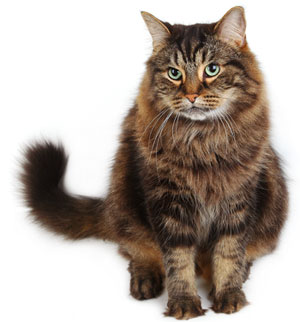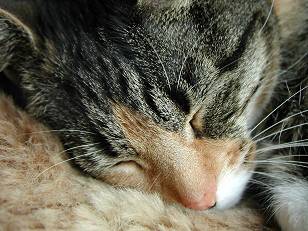 |
Euthanasia should be addressed on an individual basis in consultation with your veterinarian Allowing your kitty to live with is a viable option even if you have other kitties at home, even if your other kitties may or may not test positive. But they should never be exposed to other kitties nor under any circumstances should they be allowed to roam outside.
Treating your kitty with good supportive and loving care is so important even though there is no specific treatment or no known controlled cure. Always...Keep kitty indoors and... Give their regular vaccinations with killed virus vaccines (no feline leukemia vaccine) Control parasites, such as fleas, earmites, intestinal parasites. Early and aggressive treatment of any symptoms that appear (see above symptoms)
Tests used have a small percentage of false positive results – 1-5% Test look for viral antigens not antibodies Kittens can be tested at any age because maternal immunity does not interfere with test ELISA is the most common screening test IFA (immunofluorescent antibody) test is the most common confirmatory test Test done on tears or saliva are unreliable, it should be performed on a blood sample All cats/kittens should be tested whether ill, exposed to a FeLV positive cat or a new cat to a household. Vaccination for FeLV Does not affect test results Vaccines are about 85% effective in preventing infection with feline leukemia virus FeLV vaccines are designated as non-core vaccines and recommended only for those cats whose lifestyle places them at risk for FeLV – which include out door cats, indoor/outdoor, feral, cats in open multi-cat households, FeLV-positive households or where FeLV status of all resident cats is not known.
Therapies that have helped FeLV Kitties. AZT – Anti-viral drug- shows some promise – but has many side effects Combining AZT with interferon or interferon and another immunostimultant – Propionibacterium acnes. Immunotherapy: Staph protein A – (ProZyme)- digestive enzyme (1/4 tsp per 1 cup food)Immunoregulin: Not recommended once cat develops any type of lymphosarcoma, cat must be taken off Prednisone at least a week before starting treatment unless severe anemia is noted. It is a biological product which can stimulate the immune system to defend itself against disease. It is administered intravenously giving 2 injections a week for one or two weeks, then one injection a week until symptoms are alleviated. Acemannan: (Carrisyn) – Oral doses are not yet available4. Baypamum: Not available in North America due to FDA concerns. (it’s cultured on Bovine kidney tissue) possibility of MDC. Studies are being done at Bayer Company in Kansas. Moducare and Hyproxin: Plant “fats” present in every single plant (fruits and vegetables). Chemically very similar to the animal fat, cholesterol but totally different in biological functions. They modulate the functions of the T cells - specialized cells which fight off offenders which live inside the host’s cells (e.g. Viruses, certain bacteria, etc. Dimethylglycine (DMG): A tertiary amino acid, a derivative of glycine and a natural component of animal and plant metabolism. It supports transmethylation processes through its ability to give up its methyl groups to help produce Sulfur- adenosylmethionine (SAMe)-pet formula only, do not split or crush. A very good generic brand is Denysol. It also protects against many forms of physical, metabolic and environmental stress. This is a great source of sacosine, glcine, serine, etc, modulates T and B cells and their products, impacts immune modulation and oxidative processes. Interferon: Good anecdotal reports of helpfulness and success in treatment of ill cats but no reports of it actually clearing the virus under controlled conditions. Blood transfusion: Help some cats. Appetite stimulants: Diazepam, oxazepam and cyprobeptadine Hill’s A/D diet. Haemobartonellosis: Treatment for a blood parasite, sometimes a complicating factor in FeLV It is responsive to doxycycline (10mg/kg of body weight once a day) Doxycycline is of the Tetracycline family. Alternative Care: Additional support is needed to reverse symptoms Symptoms may reappear with disregard of supplementation protocol Vitamins A, E, B-Complex and C plus the minerals Iron, Zinc, Copper Pet-Tinic – liquid vitamin mineral supplement with Iron Life Force super Antioxidants and Vital Charge– made by Infinity 2 Feline Leukemia virus Kit – Cell Restore (herbal-Atractylodes (alba), Cudrania, dioscorea, Momordica charantia, Paeonia, Sophora), Cell Enhancer (herbal-Coix, Cymbopogon, Garcinia, Sarcandrae, Sprouted Rice), Virus Fighter (herbal- Andrographis, Angelica Dong Quai, Astragalus, Lonicera Flower) Transfer Factor-boosts the immune system to help defend the body from all kinds of disease, infection and intrusion. Contains over 40 valuable nutrients, including amino acids, probiotics, essential fatty acids and 25 vitamins and minerals considered essential for the optimal health of your cat. Also includes a synergistic blend of glucosamine and chondroitin, designed for felines. It is a lymphokine – the two most notable lymphokines are interferon and interleukins. The need to use antibiotics is lessened. Transfer Factor can stimulate a better immune response to respiratory bacteria, skin pathogens and various viruses. Mix own food
|




